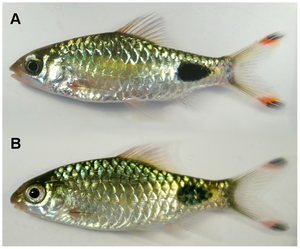Black-spotted barb
| Black-spotted barb | ||||||||||||
|---|---|---|---|---|---|---|---|---|---|---|---|---|

Black-spotted barb, Dawkinsia filamentosa (above, below Dawkinsia assimilis ) |
||||||||||||
| Systematics | ||||||||||||
|
||||||||||||
| Scientific name | ||||||||||||
| Dawkinsia filamentosa | ||||||||||||
| ( Valenciennes , 1844) |
The black-spotted barb ( Dawkinsia filamentosa , Syn . : Puntius filamentosus , Barbus filamentosus ) is a freshwater fish from the carp family (Cyprinidae). It occurs in southern India in the coastal plains of Kerala and Karnataka and in Tamil Nadu . Reports of occurrence in Sri Lanka are based on confusion with the similar and closely related Dawkinsia singhala .
features
The black spot barb is 15 to a maximum of 18 centimeters long. Their bodies are laterally flattened and elongated than that of most of the other barbel from the Puntius family. Characteristic for the males of the species are the thread-like elongated front, divided dorsal fin rays, which are the reason for the scientific name of the species ( Latin : "filamentosus" = thread-like) and in some cases can extend beyond the caudal fin base. The black-spotted barb differs from the closely related species D. assimilis by its almost terminal mouth, while that of D. assimilis is subordinate. The black-spotted barb has none, more rarely a rudimentary pair of barbels that only reach 0.5 to 2.2% of the standard length .
- Fin formula : Dorsal : 2/8; Anal : 2/5; Pectorals : 1 / 14-15.
- Dandruff formula : mLR 18-20 + 1-3.
The color of the black-spotted barb changes with age. Young fish are yellowish with three horizontal stripes on the body sides, one below the dorsal fin, one above the anal fin and the third, narrow one on the caudal fin stalk. The fins are transparent. From a length of six centimeters, the drawing goes back to the sides of the body. Only from the transverse band above the anal fin remains a thick black spot, which led to the German name of the species. Sexually mature black-spot barbs are silvery, green-silvery to yellowish and shimmer in all colors of the rainbow when light hits them. Their top is darker and olive. The dorsal fin is bright red, its fin rays purple. The forked caudal fin is reddish with white tips and black spots below the tips. Their outer fin rays are dark brown. The other fins are slightly yellowish. At spawning time, the belly becomes reddish and the fish develop a spawning rash above the mouth .
Way of life
The black-spotted barb is found in clear rivers, estuaries, swamps, lakes and ponds of the lowlands. It tolerates light brackish water and is often found very close to the sea together with typical brackish water fish. It feeds on plant material, among other things. Spawning females lay 300 to 500 eggs, which stick easily and stick to the tangle of plants. The larvae hatch after two days and swim free after another two days.
Systematics
The black-spotted barb originally belonged to the genus Puntius and was the eponymous species of the eight species P. filamentosus species group, a group of closely related South Indian Puntius species. The group has since become an independent genus as Dawkinsia .
literature
- Günther Sterba : Freshwater fish of the world , Weltbild Verlag, Augsburg 1998, ISBN 3-89350-991-7 .
- Axel Zarske: Barbus filamentosus. In: Claus Schaefer, Torsten Schröer (Hrsg.): The large lexicon of aquaristics. Eugen Ulmer, Stuttgart 2004, ISBN 3-8001-7497-9 , p. 130.
- Rohan Pethiyagoda, Maurice Kottelat : A review of the barb of the Puntius filamentosus group (Teleostei: Cyprinidae) of southern India and Sri Lanka. Raffles Bull. 2005 Supplement No. 12: 127-144 PDF .
Web links
- Black-spotted barb on Fishbase.org (English)
- Dawkinsia filamentosa inthe IUCN 2013 Red List of Threatened Species . Listed by: Abraham, R., 2010. Retrieved December 18, 2013.